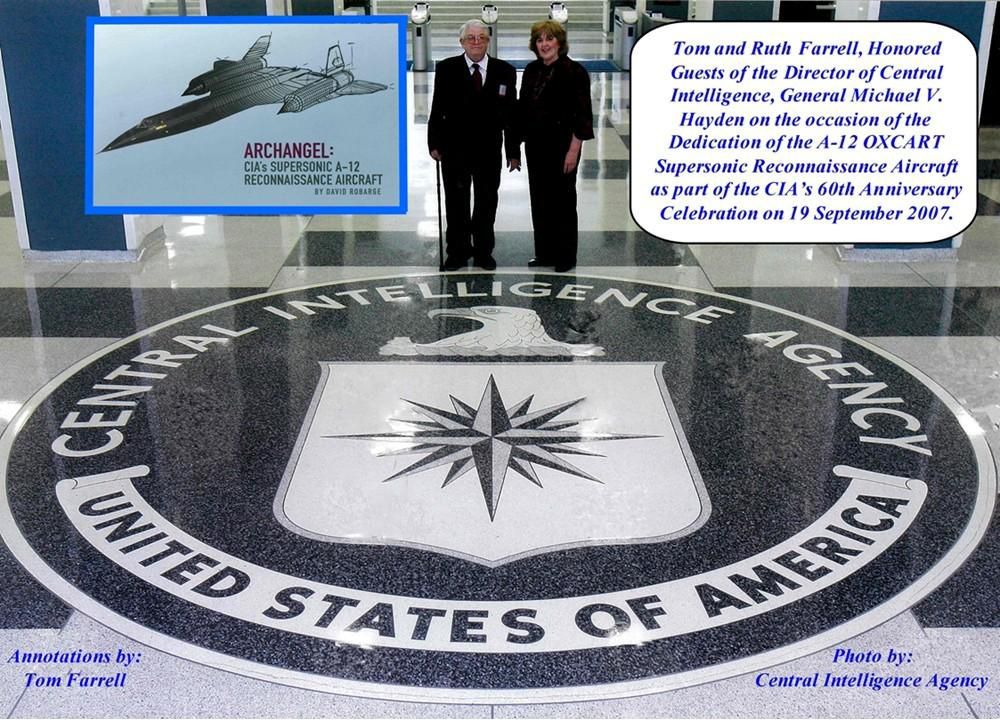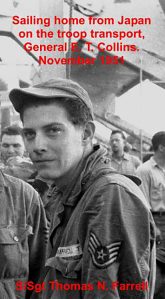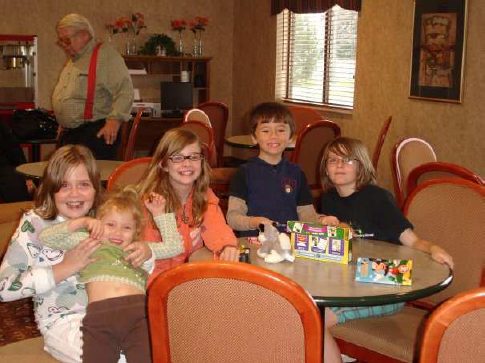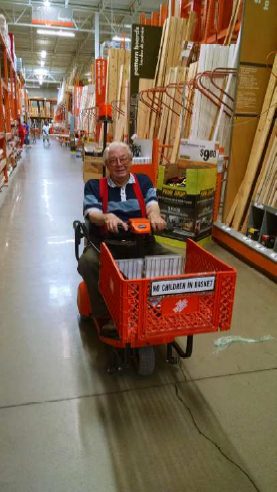


 |
 |
 |

CIA's Supersonic Reconnaissance aircraft, the A-12 OXCART, flew its first operational mission (Black Shield 0001) over North Vietnam on 31 May 1967.
President Lyndon Johnson approved the mission the middle of May, and requested CIA Director Richard Helms to have the initial photography scanned as soon as possible in a search for Soviet Surface-to-Surface missiles similar to those placed in Cuba in 1962.
After the mission was completed, Director Helms called Art Lundahl, Director of the National Photographic Interpretation Center (NPIC). Art called me to his office and gave me the assignment to take an Agency plane, and fly to Eastman Kodak in Rochester, NY where the film from the mission was processed. Art gave me the telephone number of the White House Situation Center and instructed me to call the White House and report any missiles I observed.
Because of this assignment I became the first Intelligence Analyst to view the photography collected on the first A-12 operational mission. It was a unique position in my career.
This was where "the rubber meets the road." The "bird had left its nest."
Thomas N. Farrell
CIA/NPIC Senior Intelligence Analyst, Retired
Tom Farrell's Career
This, in a nut shell, is the summary of Tom Farrell's Intelligence Career. When Tom retired from the government in 1977 John Hughes sent him an inscribed photograph (inscription below) that reads as follows: For a detailed account of his career see Attachment #1.
To Tom Farrell November 1977
A top professional and close personal friend whose contribution to U.S.
National Security has been outstanding. Good luck and future successes.
J. T. Hughes
Deputy Director, DIA
Intelligence Collection
A picture is worth 1,000 words. 30 years after being retired from the CIA, Tom and his wife received an Honored invitation from the Director of CIA, General Michael V. Haden to take part in CIA's 60th Anniversary Celebration.

Thomas N. (Tom) Farrell has a long and distinguished career as an Imagery Intelligence Analyst working at the National Level. His career spanned the following agencies: the Central Intelligence Agency (CIA), Defense Intelligence Agency (DIA), National Security Agency (NSA), and the National Photographic Interpretation Center (NPIC). Tom developed his expertise early in his career, while working for the Armed Service Intelligence Elements of the US Army, US Navy, and US Air Force.
The start of his career in the mid 1950s saw Tom involved in the writing of almost 25 Photographic Interpretation Keys (training manuals) covering both Communist controlled Geographic areas of the world and Soviet Military Equipment.
Tom's Photographic Interpretation career started with the interpretation of large scale coverage of military installations in Soviet-occupied East Germany and closed with the interpretation of satellite reconnaissance systems at NPIC, starting with the first such system, CORONA, launched in the early 1960s.
Tom moved up to National Level Intelligence in 1963 when he was hired by DIA and assigned to the CIA's National Photographic Interpretation Center (NPIC). His career at NPIC spanned 13 years and earned him recognition at the highest levels of Government. The Director of NPIC, Art Lundhal, who briefed President Kennedy during the Cuban Missile Crisis in October 1962, greeted new employees with the statement, Your job here is a seat on the 50 yard line of history. How true that was.
Tom was involved in a number of history making projects to numerous to list. Only the highlights can be covered. Tom was the lead Analyst in writing the Strategic Arms Limitation Study (SALT) covering NPIC's staffing for support of SALT. Tom produced a professionally developed video tape which was used to brief visiting VIP's. Tom handled NPIC's VIP briefings for several years, but when video taping became available Tom worked with CIA and NSA to make use of this communication tool. Tom was involved in the training of the Astronauts selected for the Sky Lab project in 1973. Some that he trained in the recognition and interpretation of military equipment seen from orbit, went on to take part in the Shuttle project.
One briefing Tom carried out had an indirect connection to the A-12 OXCART, as well as other "Skunk Works" projects. It was a One-on-One briefing Tom gave to Mr. Kelly Johnson on one of his NPIC visits. The briefing (in 1972) covered the Earth Reconnaissance Technology Satellite (ERTS).
On one of the jobs he did, he received a written commendation from Secretary of Defense, Robert McNamara, who commented on Tom's organization and supervision of his part in a Department of Defense project as, "a monumental breakthrough in methodology." The methodology Tom used was as follows. McNamara's project involves a study of the military installations in a country that was part of the Soviet bloc. A detailed write up of each military installation in each of the Military Districts was to be produced. To provide uniformity to each of the write ups, Tom organized his team as follows. Rather than dividing the military installations and assigning a group to each of the analysts, Tom had each of the analysts work as a group on all of the installations thus providing uniformity to all installations. This insured that all the photo selections, annotations equipment counts, facility identifications and write ups appeared to have been done by one individual. There were 26 installations involved. Tom's study was the only Military District that was acceptable by McNamara.
Secretary McNamara impacted Tom's life again when McNamara and John Hughes, Deputy Director of DIA made a visit to Vietnam in 1964. This trip triggered a series of events that involved Tom in three high level projects in SE Asia. Secretary McNamara requested a Photographic Interpretation Key incorporating the material he was shown by the South Vietnam military to be produced by December and in the hands of U.S forces.
When Director Hughes returned to Washington after the Vietnam trip, he contacted each of the services intelligence organizations and put Sec/Def McNamara's request to them. John asked them to go to Saigon, review the holdings of the SVN intelligence units, collect what can be used and return to Washington. Then they were to produce a Photographic Interpretation Key (training manual) to identify the insurgent activity in Vietnam. This key was to be published in English and Vietnamese and be in the hands of the troops in Vietnam before Christmas. Each of the intelligence units told John that it was not possible to produce the training manual in that short a time frame. All three elements, Army, Navy, and Air Force, turned down the request.
John then came to the National Photographic Interpretation Center (NPIC) a joint CIA/DIA intelligence unit. He surveyed the DIA employees to determine who had the needed experience for this project. Two individuals came to the top of the list. Don Wolden and Tom Farrell -- two individuals whose careers had been connected since 1957. John explained what he needed and Don and Tom agreed to take on the assignment. A month later they were on a plane for Saigon, Vietnam and the start of a series of projects that would continue for the next three and a half years.
The second week in December of 1964, the team had English copies as well as Vietnamese copies, printed, bound, and ready for distribution to the troops. The deadline was met two weeks early.
Several months after the Vietnam manual was distributed, DIA received a request from the US Ambassador to Laos, William Sullivan, for a similar key on Laos. The Ambassador stated: "There was a problem in separating the insurgents from the various tribal groups in Laos." Our group traveled to Laos, talked with intelligence personnel, and returned with material to use in the project.
The Laos key was finished in record time.
On the way to Laos Don and Tom stopped in Bangkok, Thailand and saw on Thai TV that there was a low level problem with insurgency along the Thailand/ Laos border. After working on the Vietnam Key we were aware of the need to get an early start assessing the cultural features of a country before the Insurgents moved in. With this uppermost in our minds we sent a memo to John Hughes. John in turn contacted the Director of DIA, and the Secretary of Defense. Out of this came a joint DOD, State Department, and Thailand Government project for a Key on Thailand printed in both Thai and English.
A three-man field team was sent to Thailand for a seven-week, full country collection and survey. They had the use of CIA aircraft, and helicopters. The Ambassador's C-47 and the Air Attach as pilot, Thai Liaison officers, and any other assets we required. Our Thai contact was General Chomanand Kriangsak, head of the Thai General Staff, who was responsible for approving all US Forces assigned to Thailand. General Kriangsak became Prime Minister several years later.
The team traveled over 7,000 miles in Thailand covering the entire country. Eighty-four, 36 exposure rolls of black and white photography were exposed and forty-two rolls of color were taken. Six hours of tape recordings were made. They returned to Washington and were allowed, for the first time, the use of NPIC facilities. This came about because all team members held the required clearances for the building.
Another Key (in two languages) was produced in record time.
There is a strong possibility that the key on Thailand was instrumental in controlling the insurgency in that country. Tom believes, that if we had the Vietnam Key a few years earlier, it would have been possible to target and eliminate the insurgency before it became a full scale military action, as it did.
With the completion of the three Photographic Interpretation Keys, Tom (who was responsible for the Insurgent sections in each of the keys) was recognized in the Intelligence Community as the leading expert on the identification of insurgent activity in a jungle environment, a position he held until his early retirement from the government in the mid 1970s.
Tom's work at NPIC crossed Secretary McNamara's path again, when the B-52 Bomber was used in Vietnam in Project Arc Light. Tom was tasked with doing the Bomb Damage Assessment (BDA) of the first mission. Tom's briefing notes prompted a question by Secretary of Defense McNamara concerning the number of Viet Cong killed in the first bombing raid. McNamara's briefer, John Hughes, Deputy Director of DIA (and the individual Tom worked with on the Southeast Asian Keys) called NPIC and sent a car from the Pentagon to pick up Tom. Tom answered the question, and then participated in the press briefing that followed, Prior to the Press Briefing, an Assistant Secretary of Defense (who shall remain nameless) took Tom's Secret briefing board notes, cut the classification from the top and bottom of each page, had the edited copies reproduced, and handed them out as a Press Release.
The third B-52 mission resulted in a second contact with the Secretary of Defense. The third mission was not successfully carried out by the Air Force. About 60% of the bombs missed the one by two mile target box. The Secretary was briefed with two briefing boards sitting side by side. Tom's briefing board showed the results of the bombing with most of the craters outside the box, while the briefing board prepared by an element of the Department of Defense showed the target box laid out over the majority of the bomb craters. McNamara commented on the differences in the two briefing boards. The Officer briefing the Department of Defense board said they had shifted the target box to take in more of the bomb craters. McNamara immediately reacted with the statement, "he did not want to see anymore briefing boards from the Pentagon." From now on he wanted only NPIC briefing boards.
Shortly after that, Tom received a call from the Officer that briefed the other board who wanted to know why Tom had not shifted his target box to cover more of the craters? The Officer said, not to do so made the Air Force look bad. Tom's reply was, "the Air Force made a mistake, and it would have been a mistake on his part if he did not show the results truthfully." Tom left the caller with the thought, "do not play politics with intelligence."
It is said, everyone has "15 minutes of fame on the world's stage" at some time in their life. Tom's 15 minutes came in 1967 when he was selected to do a job for President Johnson. It was on 1 June 1967. Tom was working at the National Photographic Interpretation Center (NPIC). The Director of Central Intelligence, Richard Helms, called the Director of NPIC, Art Lundhal, and asked Art to send an Imagery Analyst to the photo processing site to scan this initial mission from the A-12 which had just flown over North Vietnam. Director Helms told Art that President Johnson wanted immediate notification of Soviet Surface-to-Surface missiles in North Vietnam similar to those in Cuba in 1962. Art picked Tom for this assignment. Tom was told what to look for on the film, given the phone number of the White House Watch Office, put on a CIA plane and sent to Rochester, New York to carry out this assignment.
Forty years later, as part of the 60th Anniversary Celebration an A-12 was set up as a monument on the CIA grounds and Tom was selected to take part in the dedication. CIA paid all expenses for Tom and his wife to attend. Tom's "15 minutes of fame" in 1967, was extended a bit in 2007 as a guest of the Director of Central Intelligence.
General Hayden, in his speech at the dedication of this aircraft on 19 September had this to say about Tom's part in this program:
The display of this aircraft will be a lasting reminder of the missions flown and the valuable contribution the A-12 made to our nation's defense. Over the course of 29 missions, OXCART imaged thousands of square miles. In fact, each over flight produced 5,000 feet of film.
Tom Farrell was the first analyst to see a frame of photography from the A-12's maiden operation. He examined it immediately after it came out of the film processor in Rochester, New York, and then hand-carried a copy to Washington on a commercial fight. As fate would have it, there were 12 Cubans aboard. All the way, he worried how he would get rid of his classified carry-on if the flight were hijacked to Cuba, a distinct possibility at the time.
But Tom made it through. In fact he's here today, as are several others who studied the A-12's photographs: Art Beidler, Mike Davis, Jim Dimon, Jimmy Lynch, and Joe Ozefovich.
These men and many others painstakingly culled through thousands of photographs'sifting nuggets of intelligence from miles of ground clutter. After the initial missions, they concluded that North Vietnam had no surface-to-surface missiles'a finding that dispelled fears of an imminent escalation of the war.
The General's full speech can be read on:
https://www.cia.gov/news-information/speeches-testimony/2007/a12-presentation-ceremony.html
Since Tom's retirement from the government in April of 1977 Tom has written Quality manuals for General Motors, worked in Quality Audit training with the U of A in Fayetteville, Arkansas, ran a family business selling pollution control equipment to the auto industry, worked with companies seeking ISO 9000 certification, written and published E-books containing declassified Cold War documents from satellite photography, developed and put on-line a number of web sites, and worked with his wife in the field of Stammering and Stuttering,
Tom, who was born in 1930, is living in Cedar Hill, Texas, just south of Dallas and is still actively involved in writing and computer projects.
His web site: http://www.thomasfarrell.com contains additional information on Tom's career. It is a "work in progress."
 Thomas Neely Farrell received his call for his homecoming to Heaven Wednesday, October 28, 2015. Tom was well respected and loved by many. From his early days growing up in Marion, Arkansas to his deployment to Japan during the Korean War, to his time inWashington, DC being on the front lines of history through his efforts at the DIA/CIA/NPIC and his retirement in Michigan, Arkansas and Texas, his life was a shining example of love of God, Family and Country.
Thomas Neely Farrell received his call for his homecoming to Heaven Wednesday, October 28, 2015. Tom was well respected and loved by many. From his early days growing up in Marion, Arkansas to his deployment to Japan during the Korean War, to his time inWashington, DC being on the front lines of history through his efforts at the DIA/CIA/NPIC and his retirement in Michigan, Arkansas and Texas, his life was a shining example of love of God, Family and Country.
Tom was involved in a number of history making projects, too numerous to list. Thomas N. (Tom) Farrell had a long and distinguished career as an Imagery Intelligence Analyst working at the National Level. His career spanned the following agencies: the Central Intelligence Agency (CIA), Defense Intelligence Agency (DIA), National Security Agency (NSA), and the National Photographic Interpretation Center (NPIC). Tom developed his expertise early in his career, while working for the Armed Service Intelligence Elements of the US Army, US Navy, and US Air Force.Only the highlights can be covered. Tom was the lead analyst in writing the Strategic Arms Limitation Study (SALT) with the Soviet Union covering NPIC's staffing for support of SALT. Tom produced a professionally developed video tape which was used to brief visiting VIP's. Tom handled NPIC's VIP briefing for several years, but when videotaping become available, Tom worked with the CIA and NSA to make use of this communication tool. Tom was involved in the training of the astronauts selected for the Skylab project in 1973. Some that he trained in the recognition and interpretation of military equipment seen from orbit went on to take part in the Space Shuttle program.
On one of the jobs he did, he received a written commendation from the Secretary of Defense, Robert McNamara, who commented on Tom's organization and supervision of his part in a Department of Defense project as, "a monumental breakthrough in methodology". The methodology Tom used was as follows: McNamara's project involves a study of the military installation in a country that was part of the Soviet bloc. A detailed write up of each military installation in each of the Military districts was to be produced. Rather than dividing the military installations and assigning a group to each of the analysts, Tom had each of the analysts work as a group on all of the installations thus providing uniformity to all installations. This insured that all the photo selections, annotations equipment counts, facility identifications and write-ups appear as if they have been done by one individual. There were 26 installations involved. Tom's study was the only Military District that was found acceptable by McNamara.
Since Tom's retirement from the government in April 1977, Tom wrote Quality Manuals for General Motors, worked on Quality Audit Training with the University of Arkansas Fayetteville, ran a family business selling pollution control equipment to the auto industry, worked with companies seeking ISO 9000 certification, written and published e-books containing declassified Cold War documents from satellite photography, developed and put online a number of websites, participated in training and active rescue events with the Benton County Search and Rescue Team, and worked with his wife, renowned stuttering solution expert, Ruth Mead in the field of Stammering and Stuttering.
Tom is survived by his wife, Ruth; son, Michael Farrell of Columbia, South Carolina, his wife, Mary Ann and their two children: David and Mae; son, John Farrell of Maryland Heights, Missouri, his wife Theresa Regan Farrell, and their 3 children: Erin, Catherine and Bridget; his brother and sister: Bill Farrell of Missoula, Montana and Coralu Buddenbohm of Memphis; step-children, Mark Mead, Daniel Mead, Katherine Konda, and John Mead and 12 step-grandchildren. Tom was preceded in death by his first wife, Mary Beth Mathis Farrell and a twin brother, baby Farrell. A Graveside Memorial will be held at the Hilltop Cemetery outside of Calvin, OK on November 25, 2015 at 2 pm. All are welcome.
He will be remembered as a man of great faith who inspired and lit up the lives of his family and friends with his great love and dedication. In lieu of flowers, the family requests that donations be sent to the Everyday Hero Support - Tom Farrell Body Camera Memorial Fund (PO Box 290357 Columbia, SC 29229) to honor his service to country and his love of photography and become a way to continue to give back to the community and support First Responders.
 |  |
 |
 |
 |